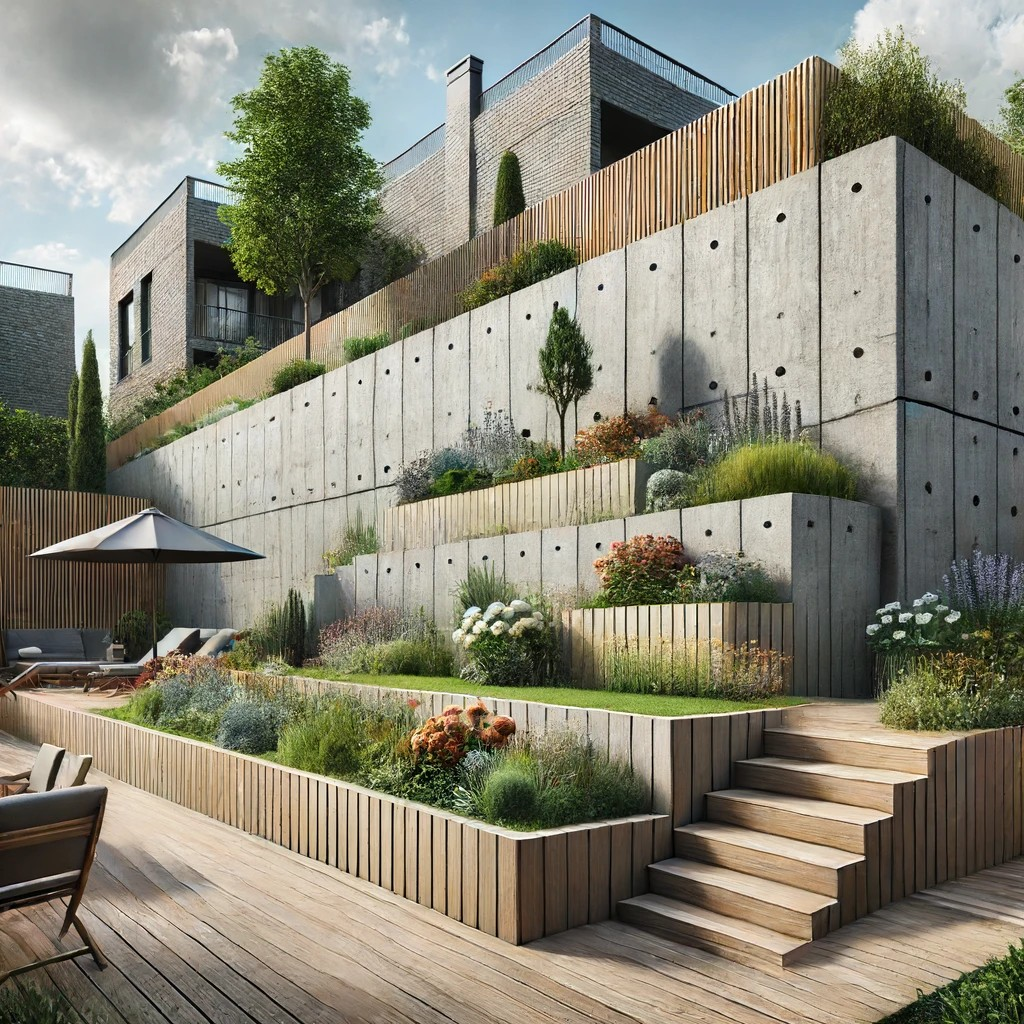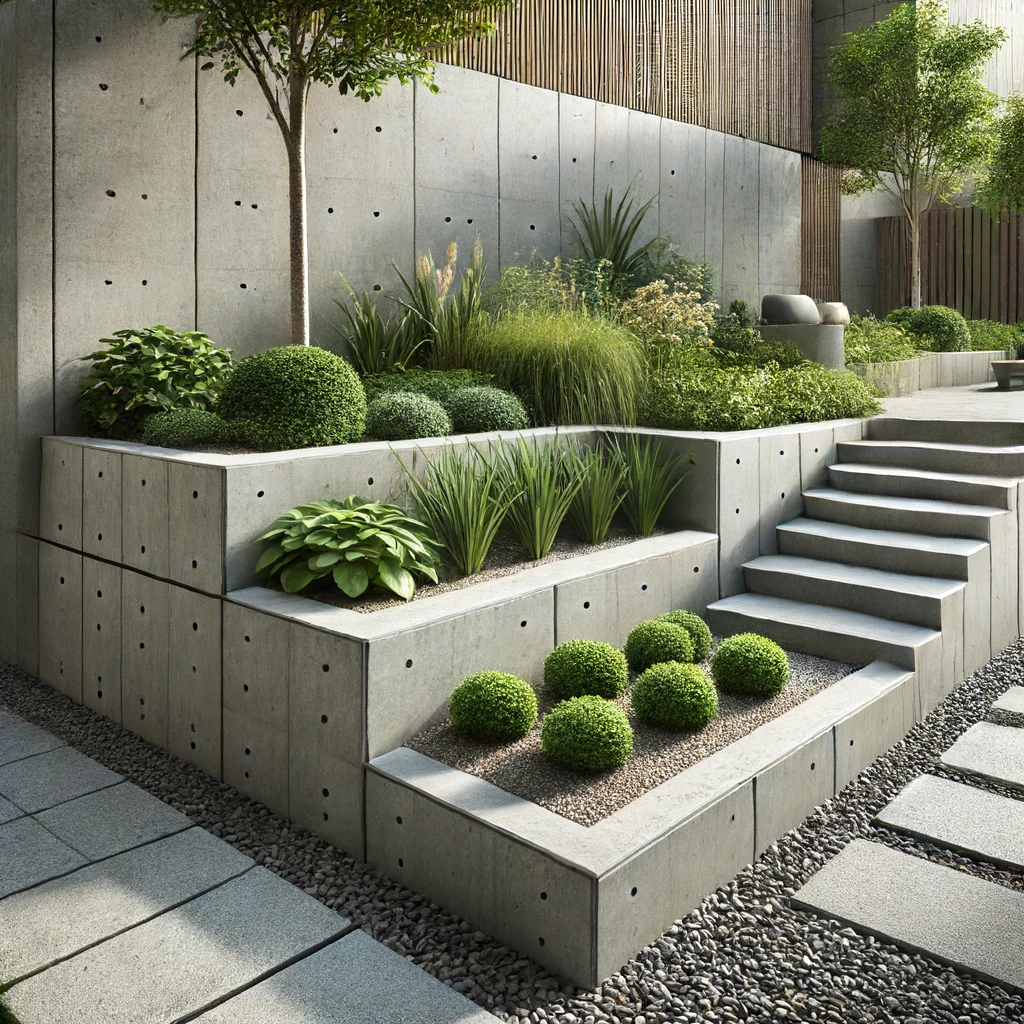What is a Cement Retaining Wall?
Cement retaining walls are a fundamental aspect of landscaping and construction. These sturdy structures are designed to hold back soil, preventing erosion and creating level spaces in uneven terrain. Whether you’re managing a sloped garden or constructing a multi-level property, cement retaining walls provide both practicality and aesthetic appeal. In this guide, we’ll dive deep into what makes cement retaining walls essential, their benefits, and how to ensure their longevity.
Benefits of Cement Retaining Walls
When considering landscape improvements or structural needs, cement retaining walls offer several advantages:
- Durability: Cement is a robust material that withstands harsh weather conditions, heavy loads, and the test of time. Unlike wood, which can rot, or stone, which can crack under pressure, cement remains solid and reliable for decades.
- Versatility: Cement retaining walls can be customized to fit any design preference. From smooth, modern finishes to textured, natural appearances, the possibilities are vast.
- Erosion Control: By holding back soil and managing water flow, these walls prevent erosion, protecting both the landscape and any adjacent structures.
- Increased Property Value: Well-designed and constructed retaining walls can significantly enhance your property’s aesthetic and functional value.
- Low Maintenance: Once installed, cement retaining walls require minimal upkeep, making them a cost-effective solution in the long run.
Types of Cement Retaining Walls
There are several types of cement retaining walls to consider, each with unique applications and benefits. Understanding these can help you choose the best option for your project.
Gravity Retaining Walls
Gravity retaining walls rely on their own weight to hold back soil. They are usually thicker and do not require additional reinforcement. Ideal for lower walls, these are often used in residential landscaping.
Reinforced Retaining Walls
For taller structures or those requiring extra strength, reinforced retaining walls incorporate steel bars or mesh within the cement. This reinforcement provides additional stability and support, making them suitable for more demanding projects.
Cantilever Retaining Walls
Cantilever retaining walls use a design that leverages the weight of the soil they retain to stabilize themselves. These walls have a thinner profile and extend further into the ground, providing robust support without the need for excessive material.
Anchored Retaining Walls
When facing extreme loads or difficult conditions, anchored retaining walls are the go-to solution. These walls use cables or other anchoring mechanisms driven deep into the soil or rock behind the wall, offering unmatched strength and stability.

Design Considerations for Cement Retaining Walls
Designing a cement retaining wall involves more than just choosing the type. Here are some crucial factors to consider:
Wall Height
The height of your retaining wall will significantly impact its design and construction. Taller walls need more substantial bases and reinforcement to handle the pressure from the soil they retain.
Soil Type
Different soils exert varying levels of pressure on retaining walls. For instance, clay soils hold more water and exert more force, requiring stronger walls, while sandy soils are lighter and may need less reinforcement.
Drainage
Proper drainage is essential to prevent water buildup behind the wall, which can lead to failure. Incorporating weep holes, drainage pipes, or gravel backfill helps manage water flow and maintain the wall’s integrity.
Aesthetics
While function is critical, the appearance of your retaining wall should complement your property’s design. Consider finishes, textures, and colors that blend well with the surrounding environment.
Steps to Building a Cement Retaining Wall
Building a cement retaining wall requires careful planning and execution. Here’s a step-by-step guide to help you understand the process:
- Planning and Design: Determine the wall’s purpose, height, and location. Consult with a professional to ensure your design meets structural and regulatory requirements.
- Site Preparation: Clear the area of vegetation and debris. Mark the wall’s layout and excavate the foundation trench to the necessary depth.
- Foundation: Pour a solid concrete base for stability. This foundation should be wider than the wall and deep enough to prevent shifting.
- Formwork and Reinforcement: Set up forms to shape the wall. If you’re building a reinforced wall, place steel bars or mesh within the forms.
- Pouring the Cement: Mix and pour the cement into the forms, ensuring it’s evenly distributed and free of air pockets.
- Curing: Allow the cement to cure properly. This process can take several days, during which the cement gains strength.
- Finishing: Once the wall has cured, remove the forms and apply any desired finishes. This could include smoothing the surface or adding textures.
- Drainage and Backfill: Install drainage features and backfill the area behind the wall with gravel or soil, compacting it to avoid future settling.
Maintenance Tips for Cement Retaining Walls
Although cement retaining walls are low maintenance, regular checks and minor upkeep can extend their lifespan and ensure they remain effective:
- Inspect Regularly: Look for signs of cracking, bulging, or leaning. Addressing minor issues early can prevent major repairs.
- Manage Vegetation: Keep plants and roots from growing too close to the wall, as they can exert pressure and cause damage.
- Clean Drainage Systems: Ensure weep holes and drainage pipes are clear of debris to prevent water buildup.
- Seal and Protect: Consider sealing your wall to protect it from moisture and weathering. This is particularly important in climates with freeze-thaw cycles.
Common Issues with Cement Retaining Walls and How to Fix Them
Even the best-built cement retaining walls can face challenges. Here are some common issues and their solutions:
Cracking
Cracks can develop due to settling, weather changes, or excessive pressure. Small cracks can be sealed with cement-based fillers, while larger ones might require professional repairs.
Bulging or Leaning
This is often a sign of structural failure due to inadequate design or drainage. Addressing drainage issues and reinforcing the wall might be necessary.
Erosion
Soil erosion at the base of the wall can undermine its stability. Adding gravel or reinforcing the base with concrete can prevent further erosion.
Choosing the Right Professional for Your Cement Retaining Wall
Selecting the right contractor is crucial for the success of your cement retaining wall project. Here’s what to consider:
- Experience and Expertise: Look for contractors with extensive experience in building cement retaining walls. Their expertise ensures a solid and durable construction.
- Reputation: Check reviews and ask for references. A reputable contractor will have a history of satisfied clients and successful projects.
- Licensing and Insurance: Ensure the contractor is licensed and insured, protecting you from liabilities during the construction process.
- Detailed Estimates: Request detailed quotes that outline the cost of materials, labor, and any additional services. This helps you budget accurately and avoid surprises.
- Clear Communication: Choose a contractor who communicates clearly and listens to your needs. Good communication ensures your project is completed to your satisfaction.
Conclusion
Cement retaining walls are an essential component in many landscaping and construction projects. Their durability, versatility, and aesthetic potential make them a popular choice for managing slopes and creating functional spaces. By understanding the types, design considerations, and maintenance tips, you can ensure your retaining wall is both effective and long-lasting. Whether you’re a homeowner looking to enhance your garden or a developer managing large-scale terrain, cement retaining walls offer a robust solution for your needs.
At Unlimited Drilling & Foundations, we pride ourselves on our expertise in constructing high-quality cement retaining walls. With years of experience and a commitment to excellence, we’re here to help you bring your vision to life. Contact us today to discuss your project and see how we can assist in creating a lasting and beautiful retaining wall.

